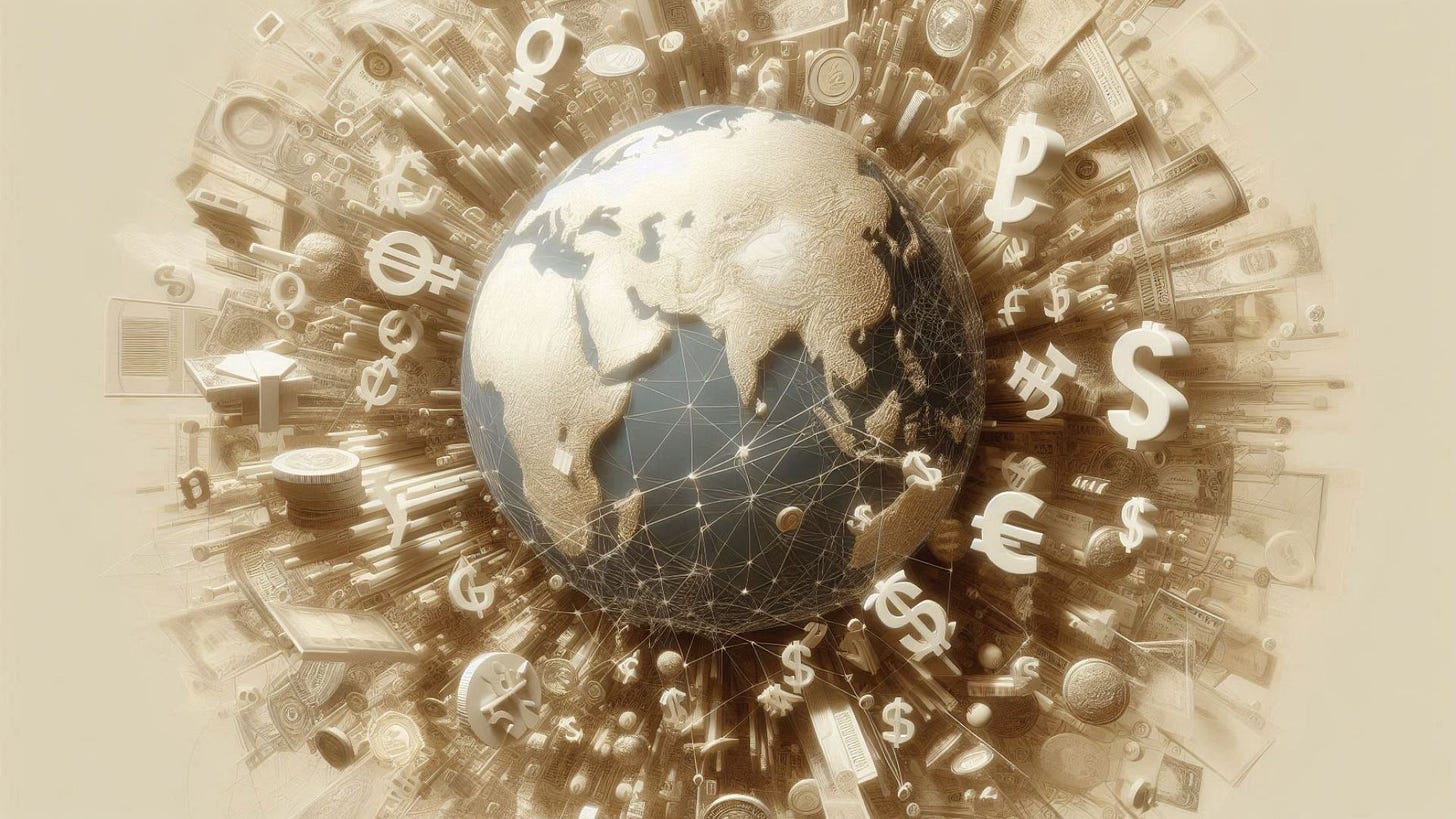Listen to the audio version >>
The convergence of crises now often referred to as “the polycrisis” was heralded by the global economic crisis known as the Great Recession. Since then neither national nor global institutions have proven able to control the destructive gyrations of the global economy.
The quarter century following World War II has often been called the Golden Age of Capitalism. Many countries instituted what came to be known as “regulated capitalism” with “Keynesian” techniques of fiscal and monetary policy providing stimulus that largely forestalled the boom-and-bust cycles that had characterized capitalist economies. The International Monetary Fund created by the Bretton Woods Agreement at the end of World War II, which supported fixed exchange rates among national currencies, reinforced the ability of nations to regulate their economies. The US dollar served as the reserve currency for the whole system, letting the US Treasury function as a world central bank, printing money to promote economic growth as it saw fit. The years from 1948 to 1973 saw global growth rates of nearly 5 percent per year.
In the early 1970s capitalism entered a worldwide crisis. Global economic growth fell to 2.5%, half its former rate, and profit rates fell comparably. In response to this continuing crisis, the Bretton Woods system was largely abandoned. Keynesianism was renounced in favor of what has come to be known as “neoliberalism.”
What actually happened to the global economy in the era of neoliberal globalization has been brilliantly analyzed by economic historian Adam Tooze, and I will draw heavily on his analysis here.[1] Two key trends reshaped the conditions for national economic regulation: corporate globalization and global financialization. These are related, because a large proportion of global finance goes to finance international trade.
Corporate globalization From the 1960s to 2007 trade growth as a proportion of global GDP increased steadily, from less than 10% to nearly 20%.[2] This globalization was highly concentrated in a very small number of companies. In the case of the US, in 2007 about one-third of industrial firms exported, but four-fifths of the value of exports was accounted for by one-twentieth of those firms – less than 2 percent of all firms. In the era of globalization, as Tooze put it, the “dominant force in the global economy” was no longer “national units” but “giant corporations.”
Financialization The era of neoliberal globalization was marked by deregulation of national financial markets and a qualitative shift in the role of finance vis-à-vis the “real,” nonfinancial economy. This shift has been registered among economists in what is referred to as the “macrofinancial approach,” which describes the emergence of a new global financial system. (Tooze generally puts “system” in scare quotes, suggesting it is too disorderly and uncontrolled to deserve to be called a system.)
This “macrofinancial approach” argues that today, “money is endogenously generated” not so much by national governments as by the credit “system” itself. That credit “system” consists of an “oligopolistic and heterogeneous collection of banks, shadow banks, funds of various types and the money market.” This “system” originally grew out of efforts to circumvent the Bretton Woods rules by moving financial operations to the City of London and other offshore financial centers; it was transnational from the get-go.
This credit “system” is not just part of one or another nation state; it relates to “the state system” as a whole, and to “the US state apparatus (Treasury-Fed) above all.” Whatever the designated nationality of particular financial institutions, the credit “system” and in particular the banks live in “an incestuous relationship with the state represented by both the treasury (which issues the chief safe asset in most financial systems i.e. government bonds) and the central bank.”
Finance: Out of Control
This new financial “system” created enormous problems for national economic regulation. The “system” is “profit-driven” and has “strong pro-cyclical tendencies,” that is, “it expands during an upswing, amplifying the updraft.” It is “liable to implode” during downswings.[3] States can stimulate or slow economic activity. But where that activity will take place is something that is largely beyond their control because the credit “system” disperses the effects of their actions around the world.
These problems became progressively more visible in a series of regional and global financial crises, reaching their acme (so far) in the financial meltdown of 2007-8 and the subsequent Great Recession. As described by Tooze,
A system characterized by massive corporate interlock faced meltdown. But it lacked an equivalent transnational stabilizing agency. De facto it was therefore the central bank of the United States, the Fed, that emerged as the lender of last resort for the entire global banking system.
As a slogan popularized by Occupy Wall Street put it, “Banks got bailed out; we got sold out.”
The crisis was met by what might be called “Quickie Keynesianism,” in which the US government supplied virtually unlimited credit to favored borrowers to limit the financial crash, while the US and other governments around the world opened the fiscal spigot and ran unprecedented budget deficits to restore demand and thereby counter meltdown. Top UN officials called for a “Global Green New Deal” that would use such stimulus to reduce poverty and climate destruction. But what followed Quickie Keynesianism was not a return to either nationally or globally regulated Keynesian policies. Instead, there was a wave of extreme austerity which marginalized talk of a “Global Green New Deal,” crushed several national economies, led to mass impoverishment, and stimulated a political backlash that took increasingly xenophobic, nationalist, and para-fascist forms.
While a full depression was averted, austerity produced an extended period of economic stagnation. Then the global economy was wildly disrupted by the COVID pandemic. Again, Keynesian monetary and fiscal stimulus was resorted to in order to prevent global economic meltdown. In a largely uncontrolled global economy, that was followed by an extreme wave of inflation that was anticipated by few governments, economists, or pundits. That has in turn been addressed by a new wave of extreme austerity. Central banks in rich countries raised key interest rates to the highest levels since before the Great Recession. By October 2023, the US federal funds rate was over 5.3%; European Central Bank rates were over 4%.[4] The effectiveness and potentially destructive side effects of this new austerity are still being tested. Modest reductions in US interest rates are so far inadequate to undo the damage that high interest rates have wreaked on the poorer nations of the world.
Since the 2007 financial crisis there has been some effort to monitor and regulate the new global financial “system.” This is made difficult, however, because that “system” actually consists of flows that constantly crisscross national borders. An international system for stress testing and monitoring “Globally Systemically Significant Financial Institutions” is now trying to track the global economy “not in terms of national aggregates, but transnational balance sheets.” But the mapping of transnational flows, especially financial flows, is still in its infancy, and the information that would allow such mapping is mostly inaccessible, locked up in the vaults of the large global corporations. The real structure of production, supply, and credit chains is so far largely unknowable.
In the era of globalization, traditional Keynesian national macroeconomic policies (fiscal and monetary stimulus or restraint) already had limited effect. In the era of polycrisis, the global economy is being reshaped by the fragmentation of global economic networks. And it is increasingly being reshaped by escalating rivalry among the great and even the lesser powers.
These forces further undermine the possibility of either national or international macroeconomic regulation that can shape economic growth or development. The next phase of the global economy is likely to be shaped by “geopolitics uber alles.”
Welcome to the polycrisis.
[1] Adam Tooze, “Framing Crashed II: 2008, the Crisis of the National Macroeconomics and the ‘Revolution’ of Macrofinance,” Adam Tooze Blog, July 5, 2018. https://adamtooze.com/2018/07/05/framing-crashed-ii-2008-the-crisis-of-the-national-macroeconomics-and-the-revolution-of-macrofinance/
[2] Adam Tooze, “Chartbook 198 Globalization: The shifting Patchwork,” including chart. Chartbook, February 27, 2023.
[3] Tooze, Ibid. https://adamtooze.com/2018/07/05/framing-crashed-ii-2008-the-crisis-of-the-national-macroeconomics-and-the-revolution-of-macrofinance/
[4] Lee Beck and David Yellen, “How geopolitics will shape climate action in 2024:4 trends,” Clean Air Task Force US, November 30, 2023. https://www.catf.us/2023/11/how-geopolitics-will-shape-climate-action-in-2024-4-trends/







